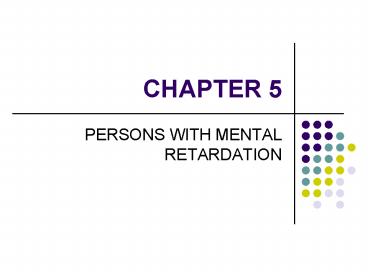PERSONS WITH MENTAL RETARDATION - PowerPoint PPT Presentation
1 / 19
Title:
PERSONS WITH MENTAL RETARDATION
Description:
2. What are four ways to classify persons with mental retardation? ... Primary Amniocentesis; chorionic villus sampling, ultrasound, prenatal screening ... – PowerPoint PPT presentation
Number of Views:376
Avg rating:3.0/5.0
Title: PERSONS WITH MENTAL RETARDATION
1
CHAPTER 5
- PERSONS WITH MENTAL RETARDATION
2
Chapter 5 E.Q.s
- 1. How is mental retardation defined?
- What is Intelligence Quotient?
- What is Adaptive Behavior?
- 2. What are four ways to classify persons with
mental retardation? - 3. How have persons with mental retardation been
treated throughout history? - 4. What conditions/circumstances increase the
likelihood of mental retardation? - 5. In what ways can mental retardation be
prevented? 5A Characteristics!! - 6. What services are provided for children with
mental retardation at each developmental level? - 7. Describe three instructional methods that
foster achievement for persons with mental
retardation - 8. What types of assistive technology increase
access to and participation in learning and
living for persons with mental retardation? - 9. What trends, issues, and controversies are
associated with mental retardation?
3
1. How is mental retardation defined?
- IDEA's Definition of "Mental Retardation"
- ". . . significantly subaverage general
intellectual functioning, existing concurrently
with deficits in adaptive behavior and manifested
during the developmental period, that adversely
affects a child's educational performance." 34
Code of Federal Regulations 300.7(c)(6)
4
1. How is mental retardation defined?
- EVOLVING from 1961 present see 1992 definition
- What is Intelligence Quotient?
- An assessment of capability based on cognitive
tasks - Examples WISC-IV, Standford-Binet
Kaufman for ESL students - What is Adaptive Behavior?
- How one functions in self care, social
interactions, and understanding of basic concepts
as compared to the age group expectations
5
Measuring intellectual abilityUSE CAUTION!!!!
- Examples WISC-IV, Stanford-Binet, Kaufman
Assessment Battery for Children - Mental Age X 100 I.Q.
- Chronological Age
- Must use IQ information with caution
- Cultural bias
- May change factors can create highs
- lows
- Cannot override other factors
6
Fig. 5.2, p.147
7
(No Transcript)
8
1992 AAMR Definition
- Significantly sub-average intellectual ability
- Exists concurrently with limitations in two or
more adaptive skill areas - Manifests before age 18
- Adaptive skill areas communication, self-care,
home living, social skills, community use, self
direction, health and safety, functional
academics, leisure, and work
9
1992 definition components
10
2. What are four ways to classify persons with
mental retardation?
- By cause assumed due to presence of disorder or
medical anomaly - By IQ test results mild, moderate, severe,
profound - By educational accomplishments EMR, TMR
- By levels of support intermittent, limited,
extensive, pervasive
11
3. How have persons with mental retardation been
treated throughout history?
- Greeks, Romans - killed or put in jars at
temples or mutilated to beg or left for
adoption - Middle Ages Children of God, or marked by
Satan, or natural fools - 1800s - first treatment programs
- 1900s sterilization, asylums Kallikaks
Jukes - 1960s -1970s research, education,
normalization, deinstitutionalization
12
4. What conditions/circumstances increase the
likelihood of mental retardation?
- Prenatally Chromosome disorders,
metabolic/nutritional disorders, maternal
infections, environmental conditions - Perinatally low birth wt prematurity lack of
oxygen during delivery delivery complications - Postnatally Infections, ingestions child
abuse, head trauma, malnutrition, lack of
stimulation
13
5. In what ways can mental retardation be
prevented?
- Primary Amniocentesis chorionic villus
sampling, ultrasound, prenatal screening - Secondary PKU screening, shunts for
hydrocephalus - Tertiary early intervention, IFSP for young
community-based services for adults
14
5A What are characteristics of persons with
mental retardation?
- Attention problems attn. span short relevance
issues - Memory difficulties (due to attending problems
and generalization deficits) - Academic limitations esp. reading comp.
- Motivation learned helplessness,
outerdirectedness - Generalization difficulties applying a skill or
concept in different setting - Language development slower to develop, limited
vocabulary, grammar impaired, speech disorders
common
15
6. What services are provided for children with
mental retardation at each developmental level?
- Early intervention ed assistance, health care,
social services, family supports infant
stimulation, minimize delays, support family - School age 50 in self contained classes
functional academics, self help, vocational
training, community survival skills, more gen ed
exposure, transition plans - Adults supports for working living
independently job coaching vs. sheltered
workshops
16
7. Describe three instructional methods that
foster achievement for persons with mental
retardation
- Task analysis assess what is known, break into
small steps - Cooperative learning all contribute to goal
- Scaffolding support, feedback, change contexts,
back off gradually, much practice
17
8. What types of assistive technology increase
access to and participation in learning and
living for persons with mental retardation?
- Defined in IDEA
- Any item, piece of equipment, or product
systemacquired or commercialthat is used to
increase, maintain, or improve functional
capabilities - Compensates for the functional limitation of an
individual and helps the person function in a
natural environment - Pages 194-195
18
Assistive Technology examples
- Activities of daily living
- Hygiene, meal preparation, e-mail
- Employment
- Computer skills, mobility, correspondence
- Sports and recreation
- Participation in activity, access to events
- Communication
- Written and verbal interactions, voice
19
9. What trends, issues, and controversies are
associated with mental retardation?
- Increase in community-based activities
- Increasing need for assistive technology
- Assessment of quality of life and normalization
- Existence of a growing geriatric population
- Increase in inclusive educational placements
- Fostering of self-advocacy and self-
determination - Ethical issues and hopes for biomedical research































